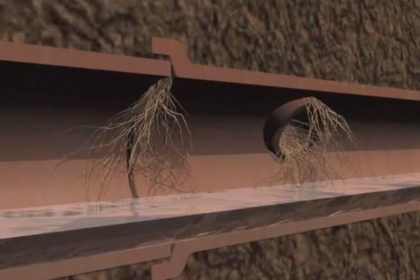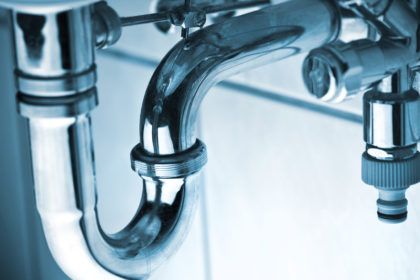To Snake or Not to Snake
All Pro Plumbing Services, Inc.
Delivering premium work and outstanding service.
To Snake or Not to Snake
When tough clogs happen, (and they will) don’t panic. Unclogging a drain can take as little as 5 minutes (in some cases).
First things first. Don’t use Draino or other liquid drain cleaner. The toxic chemicals are bad for your pipes, especially in old houses where they can’t withstand the acid. Not to mention if it doesn’t work, you’ll have a whole mess of toxicity to deal with. Also, the chemicals can react with the grease and soap in the line and make matters worse.
Which leads us to the snake; a long, flexible steel coil for dislodging stoppages in curved pipes. It costs roughly $25.00 and is worth every cent.
Using the snake is fairly simple. Push the end into the drain opening and turn the handle on the drum containing the coiled up snake. Keep pushing until you feel resistance then rotate it against the blockage until you feel it move freely through the pipe.
However, many times you can dislodge the clog before it gets to this point so before you pull out the coveted plumbing tool, start with a few of the following tips.
Kitchen Sink
Kitchen clogs are most often caused by built up grease and debris such as coffee grounds, so start at the top to search for the clog. It’s important to plunge the sink first to make sure it isn’t just below the drain. Cover the side that isn’t clogged and plunge the other. If this doesn’t work, check the disposal.
- Turn it on and if you hear a low humming sound it’s probably jammed. Unplug or turn off the disposal. Push back the rubber splash guard in the throat of the disposal. Visually inspect the inside of the disposal with a flashlight to make sure there are no broken pieces of glass or other sharp objects that could cut you. With a long screwdriver or broom handle make sure the cutting blades are free-spinning. Manually turn the blades. You can do this by inserting an Allen wrench in the bottom of the disposer and twist.
- If the disposal doesn’t make a sound when you turn it on, an internal breaker has probably tripped. Let it cool off and push the reset button on the disposal.
Still clogged? Move on to checking the “P-Trap,” named for the shape of the drain. This is the trap arm which is curved to trap some water so that sewage smells don’t creep into your house.
Sponge the backed up water from the sink to minimize the amount that will spew out when you open the drain. (Keep a bucket handy to catch the trapped water.) Once you take the drain apart, inspect for a visible obstruction.
Still no luck? Snake.
Bathtub
Ironically, the area we use to wash ourselves can get down–right gross. Start by cleaning out the strainer and stopper of hair and soap scum. The problem is usually a sticky wad of hair collecting on the cross bars just a few inches under stopper, which can sometimes be loosened with a plunger or removed with a pair of needle nose pliers. Fill the tub with a few inches of water and cover the overflow opening with a wet rag held tightly in place. Submerge a plunger and see if you can dislodge it.
If this doesn’t work, bend a stiff wire or coat hanger to form a hook and shove it through the drain. If there is a clump of tightly wound hair, you may have to cut it, and if you still can’t get it…snake.
Tubs are trickier. Instead of simply feeding the snake straight down the drain, you have to go through the overflow plate opening. To do this, put approximately 3’ of the snake down the drain until you feel a resistance. At this point, the snake should either push through or grab the clog. Once you are through the trap, move the cable back and forth while turning; you may may feel the clog. Stay close to the drain to control the snake better and clean it as you pull it back.
Run water to see if the drain is clear. If not, repeat the process. Caution, don’t push too far or you may snag the snake which could require professional help.
Bathroom Sink
The bathroom sink is one of the easier drains to unclog. Remove the pop-up stopper by disconnecting it under the sink, then pull it out from the top and clean.
If that doesn’t work, disconnect the drain trap, (again, keep a bucket handy.) These clogs can be caused by object such as a toothpaste cap or a hairband which can be quickly disposed of. If this isn’t the cause, loosen the trap arm and pull it straight out of wall. If you now see a visible obstruction, remove it. If not, put on the gloves and snake.
Toilet
Obviously the easiest method to try is plunging. The first plunge should be gentle in order to force the air out and avoid spraying water everywhere (yuck).
Plunge vigorously without breaking the seal. Stick with it, it may take 15-20 plunges. Fortunately, (or not) the most common objects plugging a toilet are toys.
Still not working? Snake.
*For toilets there is a closet auger specially designed to get through the trapway of the bowl. It also has a rubber sleeve to protect the toilet bowl from scrapes.
At this point, if it’s still clogged, call a plumber. The toilet may have to be removed to get the clog out and then reset which can be tricky.
Sewer Lines
Sewer lines should not be treated lightly. If you notice any of these signs, call a plumber.
- Gurgling noises in the drain or toilet.
- Sewer odor.
- Water back-up or flooding.
- Sewage backup.
- Water backing up out of the basement floor drain.
- Toilet bubbling or gurgling when flushed.
An ounce of prevention is worth a pound of cure.
Stay on top of your drains and you’ll have better luck keeping them clear.
- Use strainers in every drain and clean them often.
- Don’t drop bits of soap down the drain thinking it will dissolve, it won’t.
- Once a month pour a kettle of boiling water down the drain to melt grease or body oil. (Don’t do this with the toilet, it will crack the porcelain.)
- Every 3 months pour 1/2 c of baking soda down drain then slowly add a 1/2 c white vinegar and let it sit. Run hot water afterward to get rid of any last debris. (Bonus: It leaves the drain fresh!)
All Pro Plumbing services is an epic company to work with, delivering premium work and outstanding service.
Book Online
Contact Form
"*" indicates required fields
Plumbing Services
Comprehensive Solutions for Every Plumbing Need
Residential Services
Reliable residential plumbing solutions to keep your home running smoothly.
Construction Services
Professional plumbing installations for new construction and renovations.
Repiping Services
Reliable and long-lasting repiping solutions to improve your plumbing system.
Explore More From Our Learning Center

Nature vs. Plumbing
The unfortunate reality is that nature can wreak havoc on you’re plumbing system. The good news is that with regular maintenance and inspection, you can prevent damage or at least minimize the problem.
Roots
Known as “root intrusion” the name is fitting for one of the biggest culprits of broken pipes. Your sewage drainage system is crucial to the overall functionality so keeping it maintained will save you from costly repairs.
Generally, visible roots are only a portion of the entire root. Even a small puncture allows roots to grow through and obstruct the pipe. In Orlando and Central Florida, we have a high water table making it easier for the roots to seek out the water source. If you notice a slow in water flow, or if multiple fixtures such as the toilet, sink or shower start backing up, most likely you will need to repair or replace a pipe. This should be done by a professional plumber. Cleaning the interior with chemical or herbicide treatments is a temporary fix and won’t solve the real problem. Also, some of the treatments are illegal and can carry large fines.
Lightning
It’s rare to associate lightning with plumbing issues, but it’s a real concern. Especially in Central Florida which has ten times as many lightning strikes as the rest of the country. When lightning strikes the water distribution systems, it can cause pinhole leaks and sometimes even burst the pipes, costing thousands of dollars in uninsured plumbing repairs.
The theory is that lightning sends electricity shooting through the ground when it strikes. It seeks out buried, copper pipes or the home’s ground rod. It moves through the pipe until it reaches a dead end, usually at a plastic junction. The electricity needs an outlet, so the charge jumps from copper to water leaving a hole in the pipe.
To keep abreast of any damage, it’s wise to do a visual check for leaks by inspecting all appliances and fixtures that need plumbing. If you find a leak, get a professional pressure test and repair even small leaks before they get worse.
Warm Weather
Heat is also damaging to your pipes. When the ground dries out from lack of rain, it causes the house to settle which can cause your water main to crack or leak. Ultraviolet Rays can also damage exposed pipes so be sure to cover them with insulation.
Buried pipes have an increased water pressure which adds strain to the pipeline walls. Older pipes are often made of concrete making them more susceptible to breakage.
It’s important to keep the ground as moist as possible, however, with the increasing need for water conservation, watering around the foundation is most important.
If you suspect damage, call All Pro, we’ll find the cause and fix the problem.

Beating Backflow
When it comes to plumbing systems, there are a lot of things we take for granted- clean water being one of them. But this necessity isn’t a given. Contaminated water can enter your private water system, or even worse, the municipal system. Fortunately, there’s a stop-gate for that— literally.
Here’s how it works. Water should be a one-way flow, but when normal water pressure drops from things like a water line breaking, or a fire hydrant being used, causes the pressure to drop which reverses the supply water sucking contaminated water back into the system. This can happen from any source that is cross-connected such as toilets, dishwashers, washing machines and sprinkler systems. A backflow devise protects your home from this happening. If the water is flowing in one direction, the backflow devise remains open. If the water flow is reversed, the backflow device creates a physical barrier to stop the contaminated water from entering.
There are three main types of backflow devices:
• Reduced Pressure Principle Assembly. This device is best for major hazard applications. It’s the most complex and therefore more expensive, but it’s the most reliable and secure.
• Pressure Vacuum Breaker Assembly. This is the most common whole-system backflow device used most often for irrigation sprinkler systems.
- Atmospheric Vacuum Breaker Assembly: This inexpensive device is used for single fixture applications such as toilets, urinals, and some faucets.
• Double Check Valve Assembly: This device is used for underground or in-line installations, meaning, the devise runs parallel with the piping of your sprinkler system.
Fresh water isn’t something to reckon with, so there is also a second line of defense, the Dual Check Valve, which controls the backup at the cross-connection point.
For new construction, ALL PRO Plumbing can help you figure out the best solution for your needs. For existing systems, it’s important to have the devices tested periodically. Because of the moving parts including internal seals and springs, a lot of wear and tear can occur.

Plumbing Problem Prevention
Face it, it’s easy to ignore your plumbing system until something goes wrong. Really easy. But taking the time to check your system can keep problems at bay, saving you a lot of time, money and hassle. So roll up your sleeves, don the rubber gloves and get to work.
Drain your water heater. Keeping your water heater clean isn’t hard, but it is important. First, turn off the power and/or gas supply to the water heater.To drain, attach a hose and drain the water into a bucket. Briefly turn on the cold water valve, which will stir up the sediment. Drain again and repeat until the water comes out clean.
Check your drains. Clogged drains can be a real mess, so do a once-over to see if you suspect one coming your way. Is there a lingering smell? Does it drain slowly? Does it get clogged frequently? If so, either shut off the valves and open up the pipes to clean them, or call a plumber. Liquid drain cleaners aren’t recommended since they can erode the pipes and make clogs worse.
Clean the toilet tank. Yes, we said the tank. Doing so can extend the lifespan of your toilet. Standing water brings about mold, and debris can erode the rubber on the plunger and flapper. To clean, turn off the water and flush the toilet. Mix 1/4 white vinegar with 1 c. water and scrub. We don’t recommend toilet tabs because they contain bleach which can erode the parts. Either way, always wear gloves.
Check for leaks. For the toilet, put a few drops of food coloring in the tank. Wait 10 minutes, and if the color leaks into the bowl, you have a leak. If you see your faucets and showerheads dripping, don’t wait to fix them. You would be surprised at how much water (and money) is wasted through drips.
Some of these suggestions can be easily handled, but if you don’t trust your skills, call an expert for a plumbing inspection. Trite as it sounds, an ounce of prevention is worth a pound of cure!
